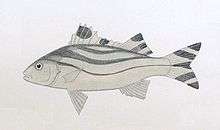Terapontidae
Grunters or tigerperches are ray-finned fishes in the family Terapontidae (also spelled Teraponidae, Theraponidae or Therapontidae).[2]. This family is part of the superfamily Percoidea of the order Perciformes.[3]
| Terapontidae | |
|---|---|
 | |
| Terapon jarbua the type species of the genus Terapon | |
| Scientific classification | |
| Kingdom: | Animalia |
| Phylum: | Chordata |
| Class: | Actinopterygii |
| Order: | Perciformes |
| Superfamily: | Percoidea |
| Family: | Terapontidae Richardson, 1842[1] |
| Genera | |
|
see text | |
Characteristics
The Terapontidae is a large family of small to medium-sized perciform fishes which occur in marine, brackish and fresh waters in the Indo-Pacific region. They are characterised by a single long-based dorsal fin which has a notch marking the boundary between the spiny and soft-rayed portions. They have small to moderate-sized scales, a continuous lateral line reaching the caudal fin, and most species lack teeth on the roof of the mouth.[4] The marine species are found in inshore sea and brackish waters, some species are able to enter extremely saline and fresh waters. In Australia and New Guinea there are a number of species restricted to fresh water.[2]
Classification
The following genera are classified within the family Terpontidae:[5][4]
- Amniataba Whitley, 1943
- Hannia Vari, 1978
- Helotes Cuvier, 1829
- Hephaestus De Vis, 1884
- Lagusia Vari 1978
- Leiopotherapon Fowler, 1931
- Mesopristes Bleeker, 1873
- Pelates Cuvier, 1829
- Pelsartia Whitley, 1943
- Pingalla Whitley, 1955
- Rhynchopelates Fowler, 1931
- Scortum Whitley, 1943
- Syncomistes Vari, 1978
- Terapon Cuvier, 1816
- Variichthys Allen, 1993
Timeline

References
- Richard van der Laan; William N. Eschmeyer & Ronald Fricke (2014). "Family-group names of Recent fishes". Zootaxa. 3882 (2): 001–230.
- R.P. Vari. "Terapontidae" (PDF). FAO. Retrieved 2 May 2020.
- J. S. Nelson; T. C. Grande; M. V. H. Wilson (2016). Fishes of the World (5th ed.). Wiley. p. 441. ISBN 978-1-118-34233-6.
- Froese, Rainer, and Daniel Pauly, eds. (2019). "Terapontidae" in FishBase. December 2019 version.
- Eschmeyer, W. N.; R. Fricke & R. van der Laan (eds.). "Terapontidae genera". Catalog of Fishes. California Academy of Sciences. Retrieved 2 May 2020.